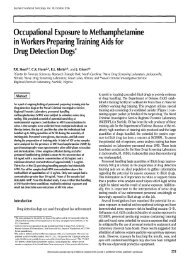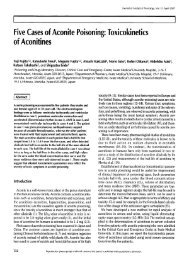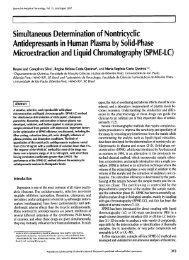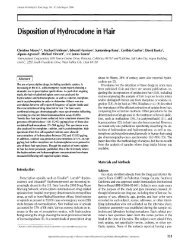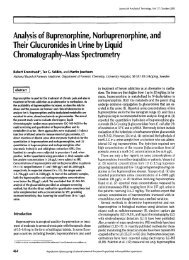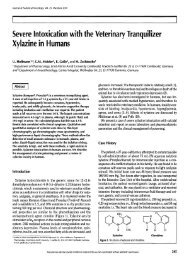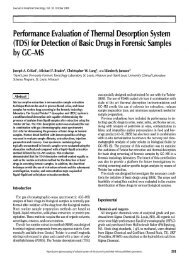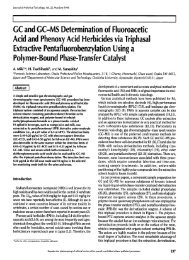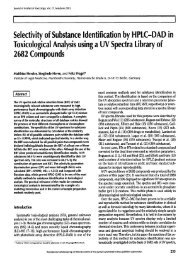Urinary Excretion Rates of Ketamine and Norketamine Following ...
Urinary Excretion Rates of Ketamine and Norketamine Following ...
Urinary Excretion Rates of Ketamine and Norketamine Following ...
You also want an ePaper? Increase the reach of your titles
YUMPU automatically turns print PDFs into web optimized ePapers that Google loves.
method, ketamine was determined in the urine <strong>of</strong> two chil-<br />
dren up to i day after exposure in concentrations ranging from<br />
41 to 695 ng/mL; in the next two children up to 2 days after<br />
drug administration in concentrations ranging from 71 to 1410<br />
ng/mL, <strong>and</strong> in one child only on the day <strong>of</strong> drug administration,<br />
when its concentration was 586 ng/mL. <strong>Norketamine</strong> was de-<br />
tected in the urine <strong>of</strong> two children up to 6 days after dosing (in<br />
concentrations ranging from 0.07 ng/mL to 1442 ng/mL), in<br />
one child up to 5 days (in concentrations <strong>of</strong> 0.6-227 ng/mL), in<br />
another child up to 7 days (0.06-430 ng/mL), <strong>and</strong> in the last<br />
child up to 14 days (0.05-57 ng/mL).<br />
Using the LC-MS-APCI method, ketamine was detected (at<br />
concentrations <strong>of</strong> 4-1204 ng/mL) in three children up to two<br />
days after exposure <strong>and</strong> in two children up to one day (at con-<br />
centrations <strong>of</strong> 12-502 ng/mL) after exposure. <strong>Norketamine</strong> was<br />
detected up to three (at concentrations <strong>of</strong> 2-409 ng/mL), five<br />
(2-1559 ng/mL), <strong>and</strong> six days (4-50 ng/mL) after drug admin-<br />
istration.<br />
Using either method, neither ketamine nor norketamine were<br />
detected in the urine taken from one child through the entire<br />
16-day period.<br />
Data from Case 2 (Table I) demonstrated that repeated doses<br />
<strong>of</strong> ketamine (three times during a two-year period) resulted in<br />
its slower elimination. After the second dose (case 2B), the<br />
elimination <strong>of</strong> parent ketamine was extended to 11 days, <strong>and</strong><br />
after the third dose it was extended to 5 days after drug admin-<br />
2<br />
mc~e !<br />
iC~se 2A<br />
DC~se 2B<br />
, ~ Case 2C<br />
i Case 3<br />
! Case 4<br />
i<br />
I 9 Case 5<br />
[ [] Case 6<br />
Figure 2. The urinary excretion pr<strong>of</strong>iles <strong>of</strong> ketamine for six hospitalized<br />
children determined by GC-MS-NCI.<br />
2 i RCase 1<br />
: 9 Case 2A<br />
DCase 2B<br />
D Ca-se 2C<br />
it Case 3<br />
m Case 4<br />
[lCase 5 1<br />
[oca.se 6 [<br />
Figure 3. The urinary excretion pr<strong>of</strong>iles <strong>of</strong> norketamine for six hospital-<br />
ized children determined by GC-MS-NCI.<br />
380<br />
Journal <strong>of</strong> Analytical Toxicology, Vol. 28, July/August 2005<br />
istration. After each dose norketamine was excreted in the same<br />
5-day period.<br />
Overall elimination times <strong>of</strong> ketamine varied between the<br />
different children <strong>and</strong> the different methods.<br />
Discussion<br />
Because ketamine has become a popular club drug <strong>and</strong> date-<br />
rape drug, it is a subject <strong>of</strong> interest to forensic toxicologists, es-<br />
pecially regarding its detection times. Detection times indicate<br />
how long after drug administration a person excretes a drug or<br />
metabolite at a concentration above a specific method LOD.<br />
This makes sensitive methods with low LODs essential. The<br />
methods used in this study allowed for quantification <strong>of</strong> ke-<br />
tamine <strong>and</strong> norketamine at very low concentrations. The<br />
GC-MS-NCI method had an LOQ <strong>of</strong> 20 ng/mL for ketamine <strong>and</strong><br />
0.05 ng/mL for norketamine, <strong>and</strong> the LC-MS-APCI method<br />
provided an LOQ <strong>of</strong> 2 ng/mL for both compounds. The applied<br />
LC-MS-APCI method is more sensitive than elaborated by<br />
Moore et al. (17) who measured ketamine <strong>and</strong> norketamine<br />
with a LOD <strong>of</strong> 4 ng/mL for both analytes. A previously reported<br />
GC-MS method achieved an LOQ for ketamine <strong>of</strong> 13 ng/mL <strong>and</strong><br />
an LOQ for norketamine <strong>of</strong> 9 ng/mL (35).<br />
Both applied methods have advantages <strong>and</strong> disadvantages.<br />
~2<br />
=<br />
9 Case I<br />
iCase 2A<br />
[]Case 2B<br />
[Case 2C<br />
i 9 Case 3<br />
D Case 4<br />
9 Case 5<br />
[] Case 6<br />
Figure 4. The urinary excretion pr<strong>of</strong>iles <strong>of</strong> ketamine for six hospitalized<br />
children determined by LC-MS-APCI.<br />
BCase 1<br />
9 C~tse 2A<br />
DC~se 213<br />
DC~se 2C<br />
9 Case 3<br />
9 Case 4<br />
9 Case 5<br />
DC~se 6<br />
Figure 5. The urinary excretion pr<strong>of</strong>iles <strong>of</strong> norketamine for six hospital-<br />
ized children determined by LC-MS-APCl.



